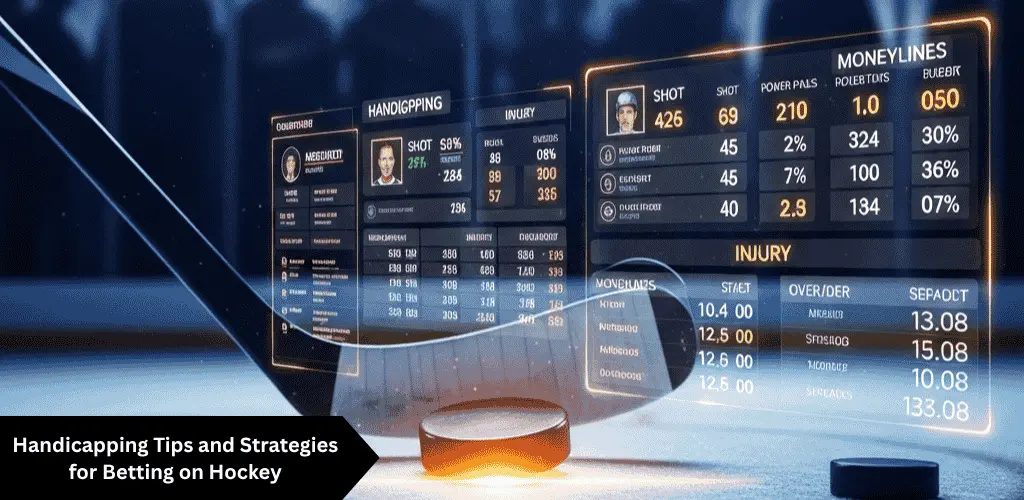Hockey is fast, physical, and unpredictable, which makes it one of the hardest sports to bet — and one of the most rewarding when you understand how to read it. Winning consistently comes down to handicapping smarter, not harder.
The NHL offers more variance than most leagues. Any team can beat another on a random night. What separates sharp bettors from casual ones is how they interpret that chaos. If you know how to read lines, goaltending trends, and key stats like expected goals or special teams efficiency, you’ll find real value where others don’t.
Table of Contents
Learn the Betting Lines
In hockey, the betting lines move quickly and often for good reason. The three core markets are the moneyline, puck line, and total goals.
Because most NHL games end with one- or two-goal margins, small shifts in odds matter more here than in other sports. A favorite one night might be a dog the next, depending on travel, rest, or goalie decisions.
When you handicap a game, don’t stop at who’s better. Look at why the line is where it is. Books set numbers based on power ratings, but they adjust heavily for goaltenders, rest spots, and injuries. Understanding that movement helps you see when a team is overvalued or undervalued.
Watch the Goalie Matchups
No single player affects a hockey bet more than the starting goaltender. The difference between an elite goalie and a cold backup can swing a game completely.
Before you make any play, check who’s in net. Teams playing back-to-backs often rotate goalies, and oddsmakers react quickly when lineups are confirmed. A backup might create value on the over, while a rested starter facing a cold offense could strengthen the under.
Also, watch for form cycles. A goalie who’s locked in over the last week or two can elevate a middling team. One struggling to find rhythm can sink even the best defense. Sharp bettors track save percentage, shot location, and rest days. You don’t have to be a stat nerd, but you do need to know who’s protecting the crease before you bet on it.
Use Expected Goals to Read True Performance
The casual bettor looks at wins and losses. The sharp bettor looks at expected goals, or xG. It’s one of the most useful analytics in hockey because it shows which team creates better scoring chances.
Expected goals measure the probability of each shot becoming a goal, based on distance and shot type. Teams with high xG numbers are generating legitimate offense, even if the puck isn’t going in right now. That often signals a team that’s underperforming — a team that could turn things around soon.
If you’re betting totals, xG is gold. When both teams push pace and create high-quality shots, the over deserves attention. When both struggle to generate chances, it’s often a slower, lower-scoring game.
Think of xG as your reality check. It tells you whether a team’s results match how they’re actually playing.
Respect the Schedule
The NHL schedule punishes lazy handicapping. Teams grind through 82 games across multiple time zones, and fatigue hits harder than the box score shows.
When you look at a matchup, check whether either team is on short rest or wrapping up a long road stretch. The second night of a back-to-back is especially important. A tired defense makes more mistakes, takes more penalties, and gives up more high-danger chances.
Rested teams generally play faster, crisper hockey. That matters most late in the season, but even now, small rest edges can swing outcomes. If a home team is fresh while the visitor is closing out a tough trip, that’s a situational edge that doesn’t always show up in the odds.
Understand Home Ice Advantage
Home ice has always been part of hockey betting, but not every team benefits from it equally. Some clubs thrive in front of their crowd, while others play the same game anywhere.
Home teams get the last line change, meaning coaches can pick favorable matchups after each stoppage. That’s an advantage against top-heavy teams that rely on one dominant line. Still, veteran teams often handle road pressure better, making them more dependable as underdogs.
Before betting, check a team’s home and road splits. If they’re consistent in both settings, you don’t need to overvalue the home edge.
Factor in Special Teams
Special teams separate good teams from great ones. Power plays and penalty kills can determine not only who wins but also whether a total hits.
If you see a matchup between a top power-play team and a penalty-prone opponent, expect more scoring opportunities. The same goes the other way — elite penalty-killing units can suppress scoring and keep games under the total.
Handicappers who ignore these details miss easy value. A single two-minute advantage can change momentum or decide the game outright.
Don’t Ignore Momentum
Streaks happen for a reason. A team on a winning streak usually isn’t “due” to lose; it’s playing connected hockey, finishing chances, and getting consistent goaltending.
Losing streaks tell a story too. Some teams keep losing despite strong underlying numbers. That’s when you look closer — if their xG remains solid and their power play keeps creating, they might be a bounce or two from a turnaround.
Momentum ties directly to confidence, and confident teams cover more often than not.
Smart Handicapping Comes from Balance
Handicapping hockey isn’t about guessing who wins. It’s about recognizing probabilities that the market hasn’t priced correctly. You’re weighing analytics, travel, matchups, and form all at once.
Keep your process consistent. Track how rest, goaltending, and expected goals interact. Over time, you’ll start to see patterns that repeat every season.
Hockey betting rewards awareness. The numbers matter, but so does timing. Pay attention to when a team is clicking or fading, and trust the data that supports your read.






